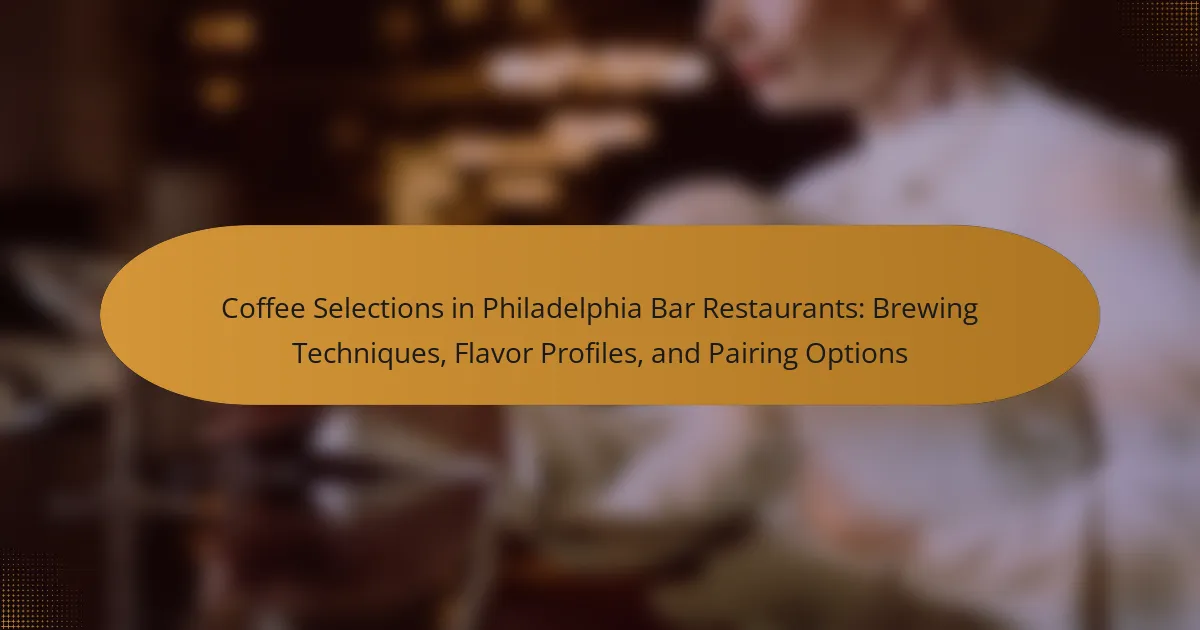
What are the Coffee Selections in Philadelphia Bar Restaurants?
Philadelphia bar restaurants typically offer a variety of coffee selections. Common options include espresso, cold brew, and pour-over coffee. Many establishments also feature specialty lattes and flavored coffee drinks. Some bars serve locally sourced coffee beans to enhance flavor profiles. Seasonal coffee beverages may be available, reflecting current trends. Additionally, some restaurants provide unique pairings with desserts or brunch items. Overall, the coffee selections cater to diverse tastes and preferences.
How do Philadelphia bar restaurants curate their coffee selections?
Philadelphia bar restaurants curate their coffee selections by sourcing high-quality beans from local roasters. They prioritize freshness and flavor, often rotating their offerings seasonally. Many establishments focus on unique blends and single-origin coffees to enhance the customer experience. Some bars may incorporate specialty brewing methods like pour-over or cold brew to showcase distinct flavor profiles. Additionally, they consider customer preferences and feedback to refine their selections. This approach helps create a diverse and appealing coffee menu that complements their food and beverage pairings.
What factors influence the choice of coffee in these establishments?
The choice of coffee in establishments is influenced by several key factors. Quality of beans is paramount, as customers prefer fresh, high-grade coffee. Brewing methods also play a significant role; establishments often highlight unique techniques to attract patrons. Flavor profiles are crucial, with a variety of options catering to diverse tastes. Seasonal availability of certain beans can affect selections, as establishments aim to offer trendy or limited-time options. Additionally, the establishment’s brand identity shapes coffee choices; some may focus on local roasters or sustainable sourcing. Customer preferences and feedback directly impact the menu, ensuring offerings align with clientele desires. Finally, price points can determine the types of coffee available, balancing quality with affordability.
How does local culture impact coffee offerings?
Local culture significantly impacts coffee offerings by shaping preferences, preparation methods, and flavor profiles. In Philadelphia, for instance, the city’s rich history influences coffee choices. Local coffee shops often incorporate regional ingredients, such as locally roasted beans. This practice reflects the community’s values and tastes. Cultural events also inspire unique coffee beverages, like seasonal blends for festivals. Furthermore, the popularity of specific brewing techniques, such as cold brew or pour-over, can be traced back to local trends. This alignment with culture enhances customer experience and fosters community connections.
What types of coffee are commonly featured in Philadelphia bar restaurants?
Espresso-based drinks are commonly featured in Philadelphia bar restaurants. These include lattes, cappuccinos, and Americanos. Cold brew coffee is also popular for its smooth flavor. Nitro coffee has gained traction due to its creamy texture and rich taste. Some establishments offer specialty coffees with unique flavor profiles. Seasonal coffee blends are frequently introduced to attract customers. Local roasters often supply these coffee selections, ensuring freshness and quality. The variety caters to diverse preferences among patrons.
What are the different brewing methods used for coffee?
The different brewing methods used for coffee include drip brewing, French press, espresso, pour-over, and cold brew. Drip brewing involves water passing through coffee grounds in a filter. This method is popular for its convenience and consistent flavor. French press requires steeping coffee grounds in hot water before pressing down a plunger. It produces a rich and full-bodied coffee. Espresso is made by forcing hot water through finely-ground coffee under pressure. This method creates a concentrated coffee with a strong flavor. Pour-over involves manually pouring water over coffee grounds in a filter. It allows for greater control over brewing time and temperature. Cold brew coffee is made by steeping coarsely ground coffee in cold water for an extended period. This method results in a smooth and less acidic beverage. Each method offers unique flavor profiles and characteristics that appeal to different preferences.
How do coffee blends vary among bar restaurants?
Coffee blends among bar restaurants vary significantly based on sourcing, roasting methods, and flavor profiles. Different establishments may prioritize local or international beans, impacting the blend’s uniqueness. Some bars focus on single-origin coffee for distinct taste characteristics. Others create proprietary blends tailored to their menu offerings. Roasting levels also differ; light roasts preserve acidity and fruitiness, while dark roasts offer a bolder, richer flavor. Additionally, the preparation method influences the final taste. Espresso-based drinks often feature blends that complement milk, while pour-over methods highlight individual bean qualities. Overall, the diversity in coffee blends reflects each bar restaurant’s identity and customer preferences.

What Brewing Techniques are Employed in Philadelphia Bar Restaurants?
Philadelphia bar restaurants commonly employ various brewing techniques for coffee. These techniques include espresso brewing, pour-over, and cold brew methods. Espresso brewing uses high pressure to extract flavors quickly. Pour-over allows for manual control over water flow and extraction time. Cold brew involves steeping coffee grounds in cold water for an extended period. Each method influences the final flavor profile of the coffee served. Bar restaurants often choose brewing techniques based on customer preferences and desired flavor outcomes. These methods help create a unique coffee experience in Philadelphia’s vibrant dining scene.
How do different brewing techniques affect coffee flavor?
Different brewing techniques significantly affect coffee flavor. Each method extracts unique compounds from the coffee grounds. For example, pour-over brewing emphasizes clarity and brightness in flavor. This technique allows for precise control over water temperature and flow rate. French press brewing, on the other hand, results in a fuller body and richer taste. The immersion method extracts oils and fine particles, contributing to a heavier mouthfeel. Espresso brewing creates concentrated flavors with a thick crema, enhancing sweetness and acidity. Cold brew results in a smoother, less acidic profile, appealing to those seeking a milder taste. Various brewing methods influence not only flavor but also aroma and texture. Studies show that brewing time and temperature are critical factors in flavor extraction.
What are the most popular brewing methods in Philadelphia?
The most popular brewing methods in Philadelphia include pour-over, cold brew, and espresso. Pour-over brewing allows for precise control over extraction, enhancing flavor clarity. Cold brew is favored for its smooth, low-acidity taste, making it a refreshing choice. Espresso is central to many coffee drinks, providing a rich and concentrated flavor. These methods are widely used in local cafes and bar restaurants, reflecting the city’s diverse coffee culture. Popular establishments often showcase these techniques, contributing to Philadelphia’s reputation as a coffee destination.
How does the brewing time influence the final taste of coffee?
Brewing time significantly influences the final taste of coffee. Longer brewing times typically extract more flavors, resulting in a bolder taste. Conversely, shorter brewing times may lead to a milder flavor profile. Over-extraction can occur with prolonged brewing, causing bitterness. Under-extraction, on the other hand, results in sour or weak flavors. The ideal brewing time varies by method; for example, espresso requires about 25-30 seconds, while French press can take 4-5 minutes. Research indicates that optimal brewing times enhance sweetness and acidity balance. The Specialty Coffee Association recommends specific times for different brewing methods to achieve desired taste outcomes.
What role does equipment play in brewing coffee?
Equipment is essential in brewing coffee as it directly influences extraction and flavor. Different brewing methods require specific tools, such as drip coffee makers, French presses, or espresso machines. Each piece of equipment affects water temperature, pressure, and brew time. For instance, espresso machines use high pressure to extract flavors quickly. Conversely, a French press allows for longer steeping, enhancing body and richness. The quality of equipment also impacts consistency and precision. High-quality grinders ensure uniform particle size, which is crucial for balanced extraction. Overall, the right equipment optimizes the brewing process, leading to better flavor profiles in coffee.
What types of coffee machines are commonly used?
Commonly used coffee machines include drip coffee makers, espresso machines, and single-serve pod machines. Drip coffee makers brew coffee by dripping hot water over ground coffee. They are popular for their ease of use and ability to make multiple cups at once. Espresso machines use pressure to force hot water through finely-ground coffee. This method produces a concentrated coffee shot known as espresso. Single-serve pod machines offer convenience by using pre-packaged coffee pods. They allow for quick brewing of individual servings. Additionally, French presses and pour-over devices are also utilized for their unique brewing methods. These machines cater to diverse preferences in flavor and strength.
How does the quality of equipment impact the coffee experience?
The quality of equipment significantly impacts the coffee experience. High-quality equipment ensures precise temperature control during brewing. This precision enhances flavor extraction from coffee grounds. Consistent grind size achieved by quality grinders leads to uniform brewing. Uniform brewing reduces the risk of over-extraction or under-extraction. Additionally, well-made brewing devices minimize the introduction of unwanted flavors. For instance, stainless steel or glass equipment does not impart any taste. High-quality espresso machines maintain pressure and temperature stability. This stability is crucial for producing rich, flavorful espresso shots. Overall, investing in quality equipment elevates the coffee experience by optimizing flavor and consistency.

What Flavor Profiles Can Be Expected from Coffee in Philadelphia Bar Restaurants?
Coffee in Philadelphia bar restaurants often features diverse flavor profiles. Common notes include chocolate, caramel, and nutty undertones. Some establishments offer fruity or floral hints, depending on the bean origin. Dark roasts tend to emphasize bold, smoky flavors. Meanwhile, lighter roasts showcase more acidity and brightness. Local roasting techniques can influence these profiles significantly. Many Philadelphia bars source beans from renowned coffee regions. This results in unique tasting experiences that reflect both local and global influences.
How do flavor profiles vary among different coffee selections?
Flavor profiles vary among different coffee selections based on factors like origin, processing method, and roast level. Coffees from Ethiopia often exhibit fruity and floral notes. In contrast, Colombian coffee tends to have a balanced flavor with nutty undertones. The processing method also impacts taste; washed coffees generally have a cleaner profile, while natural coffees may offer more sweetness and complexity. Dark roasts typically present bold, smoky flavors, while light roasts highlight acidity and brightness. These variations are influenced by the beans’ chemical composition and the environment in which they are grown.
What are the common tasting notes found in Philadelphia coffees?
Common tasting notes found in Philadelphia coffees include chocolate, caramel, and citrus. Many local roasters emphasize these flavors in their blends. Chocolate notes often provide a rich, smooth base. Caramel adds sweetness and depth to the flavor profile. Citrus notes introduce a bright, refreshing acidity. These tasting notes can be attributed to the diverse coffee bean origins used by Philadelphia roasters. Additionally, the roasting techniques employed enhance these flavors, making them prominent in the final cup.
How do origin and roast levels influence flavor profiles?
Origin and roast levels significantly influence flavor profiles in coffee. Different coffee-growing regions produce beans with distinct flavor characteristics. For example, Ethiopian coffees often have fruity and floral notes, while Colombian coffees are known for their balanced acidity and nutty flavors. Roast levels further alter these profiles. Light roasts preserve the beans’ original flavors, highlighting acidity and brightness. Dark roasts tend to bring out chocolatey and smoky flavors while diminishing acidity. According to a study by the Specialty Coffee Association, roast level can affect the perception of sweetness and bitterness. Therefore, both origin and roast levels are crucial in determining the overall flavor experience of coffee.
What pairing options enhance the coffee experience?
Pastries, chocolates, and cheeses enhance the coffee experience. Pastries like croissants or muffins complement coffee’s richness. Chocolates, especially dark varieties, balance coffee’s bitterness. Cheeses, such as brie or gouda, provide a creamy contrast to coffee’s acidity. Nuts, particularly almonds and hazelnuts, add a crunchy texture that pairs well with coffee. Fruits, like berries or citrus, offer a refreshing contrast to coffee’s robust flavors. Each pairing option creates a unique tasting experience that highlights coffee’s diverse flavor profiles.
What types of food pair well with different coffee flavors?
Fruity coffees pair well with light pastries, such as croissants or fruit tarts. The citrus notes in these coffees enhance the sweetness of the pastries. Nutty coffees complement chocolate desserts, like brownies or chocolate cake. The richness of chocolate balances the coffee’s nutty undertones. Bold, dark roasts match well with savory dishes, such as grilled meats or hearty stews. The robust flavors of the coffee stand up to the richness of the food. Medium-bodied coffees pair nicely with breakfast items, including pancakes or omelets. The balanced flavor profile enhances the breakfast experience. Lastly, spiced coffees, like cinnamon or cardamom blends, go well with spiced cakes or cookies. The spices in the food amplify the coffee’s flavor complexity.
How do seasonal ingredients affect coffee pairings?
Seasonal ingredients significantly influence coffee pairings by enhancing flavor compatibility. For instance, autumn ingredients like pumpkin and spices complement the rich, bold notes of dark roasts. Spring ingredients such as citrus fruits brighten lighter coffee profiles, creating a refreshing balance. Seasonal ingredients can also introduce unique textures and aromas that elevate the overall tasting experience. Research indicates that pairing coffee with seasonal flavors can enhance consumer satisfaction and enjoyment. This approach aligns with culinary trends that emphasize freshness and local sourcing. Therefore, using seasonal ingredients in coffee pairings not only improves flavor harmony but also supports sustainable practices in the food and beverage industry.
What tips can enhance the coffee experience in Philadelphia bar restaurants?
To enhance the coffee experience in Philadelphia bar restaurants, focus on quality sourcing and preparation methods. Choose establishments that prioritize locally roasted beans. Freshness significantly impacts flavor, so opt for coffee brewed within a few weeks of roasting. Consider trying different brewing techniques, such as pour-over or cold brew, which can alter taste profiles. Pair coffee with food options available in the restaurant to elevate the overall experience. For example, chocolate desserts often complement coffee well. Engage with baristas to learn about the coffee’s origin and flavor notes. This interaction can enrich your appreciation of the beverage.
Coffee selections in Philadelphia bar restaurants encompass a diverse range of options, including espresso, cold brew, and specialty lattes, often featuring locally sourced beans. Establishments curate their offerings based on quality, brewing methods, and customer preferences, resulting in unique flavor profiles that reflect local culture. Popular brewing techniques include pour-over and espresso, each influencing the taste and aroma of the coffee served. Additionally, the article explores how various flavor profiles and seasonal ingredients enhance coffee pairings with food, providing tips to elevate the overall coffee experience in these vibrant dining venues.




